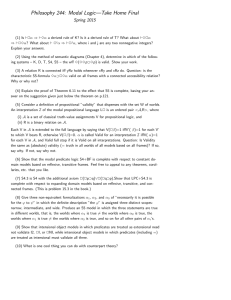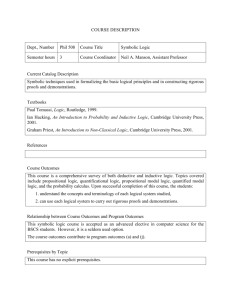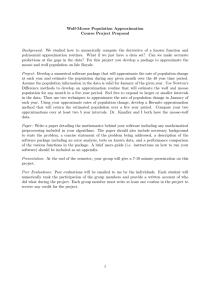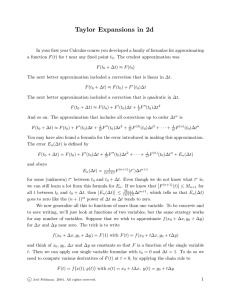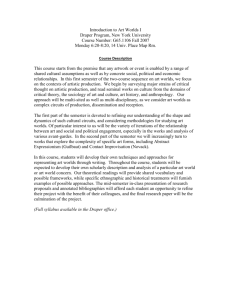Anytime Approximate Modal Reasoning Fabio Massacci
advertisement
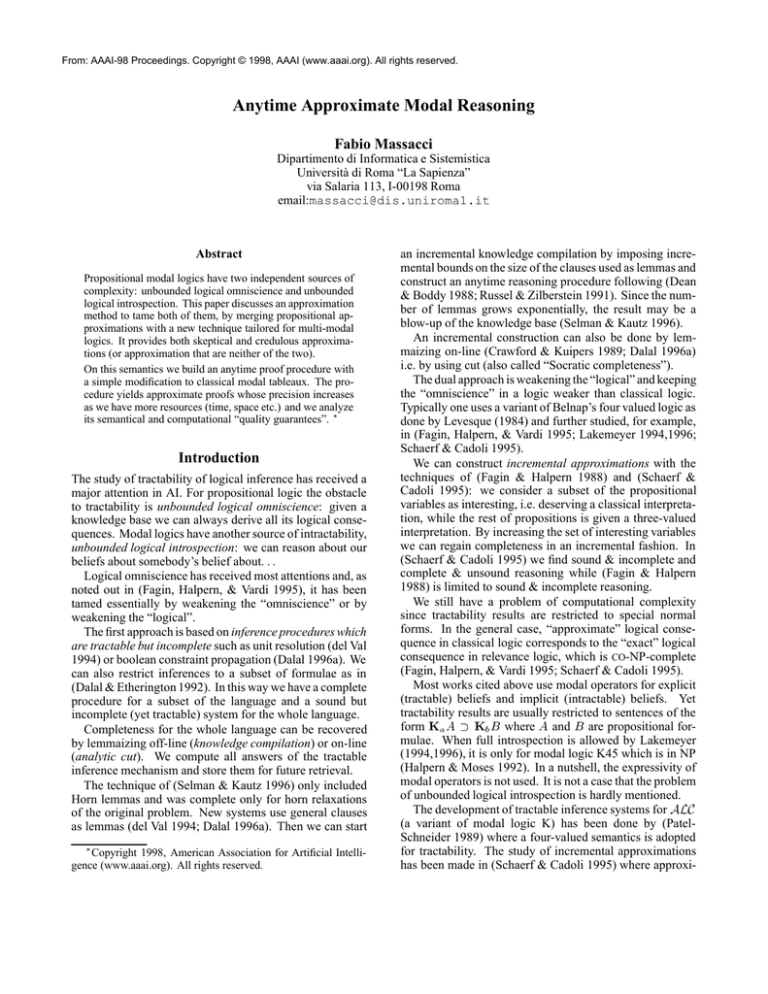
From: AAAI-98 Proceedings. Copyright © 1998, AAAI (www.aaai.org). All rights reserved. Anytime Approximate Modal Reasoning Fabio Massacci Dipartimento di Informatica e Sistemistica Università di Roma “La Sapienza” via Salaria 113, I-00198 Roma email:massacci@dis.uniroma1.it Abstract Propositional modal logics have two independent sources of complexity: unbounded logical omniscience and unbounded logical introspection. This paper discusses an approximation method to tame both of them, by merging propositional approximations with a new technique tailored for multi-modal logics. It provides both skeptical and credulous approximations (or approximation that are neither of the two). On this semantics we build an anytime proof procedure with a simple modification to classical modal tableaux. The procedure yields approximate proofs whose precision increases as we have more resources (time, space etc.) and we analyze its semantical and computational “quality guarantees”. Introduction The study of tractability of logical inference has received a major attention in AI. For propositional logic the obstacle to tractability is unbounded logical omniscience: given a knowledge base we can always derive all its logical consequences. Modal logics have another source of intractability, unbounded logical introspection: we can reason about our beliefs about somebody’s belief about: : : Logical omniscience has received most attentions and, as noted out in (Fagin, Halpern, & Vardi 1995), it has been tamed essentially by weakening the “omniscience” or by weakening the “logical”. The first approach is based on inference procedures which are tractable but incomplete such as unit resolution (del Val 1994) or boolean constraint propagation (Dalal 1996a). We can also restrict inferences to a subset of formulae as in (Dalal & Etherington 1992). In this way we have a complete procedure for a subset of the language and a sound but incomplete (yet tractable) system for the whole language. Completeness for the whole language can be recovered by lemmaizing off-line (knowledge compilation) or on-line (analytic cut). We compute all answers of the tractable inference mechanism and store them for future retrieval. The technique of (Selman & Kautz 1996) only included Horn lemmas and was complete only for horn relaxations of the original problem. New systems use general clauses as lemmas (del Val 1994; Dalal 1996a). Then we can start Copyright 1998, American Association for Artificial Intelligence (www.aaai.org). All rights reserved. an incremental knowledge compilation by imposing incremental bounds on the size of the clauses used as lemmas and construct an anytime reasoning procedure following (Dean & Boddy 1988; Russel & Zilberstein 1991). Since the number of lemmas grows exponentially, the result may be a blow-up of the knowledge base (Selman & Kautz 1996). An incremental construction can also be done by lemmaizing on-line (Crawford & Kuipers 1989; Dalal 1996a) i.e. by using cut (also called “Socratic completeness”). The dual approach is weakening the “logical” and keeping the “omniscience” in a logic weaker than classical logic. Typically one uses a variant of Belnap’s four valued logic as done by Levesque (1984) and further studied, for example, in (Fagin, Halpern, & Vardi 1995; Lakemeyer 1994,1996; Schaerf & Cadoli 1995). We can construct incremental approximations with the techniques of (Fagin & Halpern 1988) and (Schaerf & Cadoli 1995): we consider a subset of the propositional variables as interesting, i.e. deserving a classical interpretation, while the rest of propositions is given a three-valued interpretation. By increasing the set of interesting variables we can regain completeness in an incremental fashion. In (Schaerf & Cadoli 1995) we find sound & incomplete and complete & unsound reasoning while (Fagin & Halpern 1988) is limited to sound & incomplete reasoning. We still have a problem of computational complexity since tractability results are restricted to special normal forms. In the general case, “approximate” logical consequence in classical logic corresponds to the “exact” logical consequence in relevance logic, which is CO-NP-complete (Fagin, Halpern, & Vardi 1995; Schaerf & Cadoli 1995). Most works cited above use modal operators for explicit (tractable) beliefs and implicit (intractable) beliefs. Yet tractability results are usually restricted to sentences of the form a A b B where A and B are propositional formulae. When full introspection is allowed by Lakemeyer (1994,1996), it is only for modal logic K45 which is in NP (Halpern & Moses 1992). In a nutshell, the expressivity of modal operators is not used. It is not a case that the problem of unbounded logical introspection is hardly mentioned. The development of tractable inference systems for ALC (a variant of modal logic K) has been done by (PatelSchneider 1989) where a four-valued semantics is adopted for tractability. The study of incremental approximations has been made in (Schaerf & Cadoli 1995) where approxi- K K mation is essentially an incremental rewriting procedure. In the rest of the paper, we present the intuitions behind our proposal and recall some preliminaries. Then we develop an approximation for the propositional part of the reasoning, an approximation for the modal part and combine the two. Finally we show how to transform a traditional tableau calculus due to Fitting (1983) into an anytime deduction procedures for which we discuss the semantical and computational quality of the approximation. Semantical Intuitions The main intuition behind our approximate semantics stems from the observation, following (Russel & Zilberstein 1991), that the difficulty behind unbounded logical omniscience and introspection is not the “logical”, nor the “omniscience” nor the “introspection” but the “unbounded”. This difficulty is caused by the egalitarian attitude of classical modal logic: all propositional atoms are equal, all possible worlds are equal. So, we must consider a potentially exponential number of propositional assignments (unbounded logical omniscience) for a potentially exponential number of worlds (unbounded logical introspection). Therefore, logical inference has an “all-or-nothing” behavior: either we have considered (implicitly or explicitly) all worlds and all propositions and then we can answer “A is a theorem” or we don’t know what to say. The idea behind anytime reasoning is that it should be possible to interrupt our reasoning process at any time and get approximate answers whose quality improves with time and which eventually converge to the exact answer. For instance, suppose that the exact computation requires time 2cn in the worst case. An anytime reasoner gives a first approximate answer in time 2c1 and then improves the the answer in time 2c2 and so on until the exact answer is obtained or the process is interrupted. In the worst case n steps are required for completion (although we may be luckier). Anyhow, if we interrupt the process at time t we obtain the approximate answer provided at the k th checkpoint such that 2ck t < 2c(k+1) . See (Dean & Boddy 1988; Russel & Zilberstein 1991) for further details. What is difficult to grasp is the meaning of approximate answer for logical inference: what is an approximate proof or an approximate counter model? Consider the propositional case; suppose that we have coded a planning problem in propositional logic (Kautz & Selman 1992) and that we are looking for a plan (a model for the KB). To approximate logical omniscience, we start by considering just few atoms as describing interesting properties and therefore deserving a classical interpretation. Other variables stand for unknown properties and so are the formula composed with them. They don’t specify properties of “interesting models”. Other atoms corresponds to incoherent properties and do not contribute to “interesting proofs”. When we start the search for an approximate model, we process interesting formulae as usual. Each time we find an unknown formula we conclude the branch of the search with failure: at this level of approximation, interesting models (plans) do not require to give truth values to unknown propositions. When we meet incoherent formulae we simply ignore them, we assume that we can fix them later. Thus we do not consider incoherent formulae in the (approximate) proof that a plan does not exist; only contradictions between interesting formulae matter. From the viewpoint of inference, the presence of incoherent propositions leads to more models (we assume these formulae are approximately satisfied) and thus fewer proofs than classical logic (sound approximations). Unknown formulae yield fewer models (these formulae cannot be approximately satisfied) and thus more proofs (complete approximation). By suitably combining interesting, unknown and incoherent propositions we can reconstruct the tractable cases of (Levesque 1984; Schaerf & Cadoli 1995; Fagin, Halpern, & Vardi 1995) and many more. This technique is not sufficient for modal logics because of the (possibly exponential) number of possible worlds. The key observation is that interesting worlds should not be “too remote” from the real world i.e. they should be reachable with few introspection steps. We curtail the “unbounded” logical introspection by imposing that “too many” steps of introspection always lead outside interesting worlds. Again, we divide worlds into three sets: incoherent, unknown and interesting worlds. In incoherent worlds we enforce any kind of statement, including contradictory statements, while at unknown worlds we do not enforce any statement whatsoever. So we can define the notion of k -skeptical and k credulous agents: a k -skeptical agent is logical omniscient and able of introspective reasoning but only up to k levels of introspection. Afterwards, she will give up and assume that an incoherent world is reached. The dual attitude will be taken by a credulous agent. Note that the notion of incoherent and unknown worlds is substantially different from the notion of “impossible” world used in the literature (Levesque 1990). The notion of impossible world refers to “inaccessible” worlds, i.e. worlds which are not reachable via the accessibility relation Ra . Our notion is closer to the “non-normal” worlds introduced by Kripke (see (Fitting 1983)) and the “incoherent” and “incomplete” worlds of (Fagin, Halpern, & Vardi 1995)[page 212], although our use and formalization is different. We have defined two independent approximations: one for the propositional part of the logic and an approximation for the modal part. These approximations can be combined in many ways. For example, we known that incoherent formulae are approximately satisfied in interesting worlds and interesting formulae never hold in unknown worlds. So what happens to incoherent formulae in unknown worlds? One choice is to make the propositional part predominant: incoherent proposition always hold in a world, no matter which world. The opposite choice gives more importance to worlds: unknown worlds never satisfies a formula, no matter which formula. In the latter case the propositional approximation is a secondary approximation and the modal one is a primary approximation. This is our choice, mainly because it makes computations simpler. We are only left with the last step: an anytime algorithm. We decided to pick a traditional system off-the-shelves and transform it into an anytime procedure based on our semantics. The idea is to use a refutation procedure and change the termination conditions: devise complete approximations by accepting more (unknown) formulae as approximately contradictory, devise sound approximation by accepting more (incoherent) formulae as approximately satisfiable. Preliminaries on Modal Logics An introduction can be found in (Fitting 1983; Halpern & Moses 1992). We construct modal formulae A; B from atomic propositions p 2 P and agent names a 2 A: A; B ::= p j :A j A ^ B j a A We use signed formulae so that the ; ; ; notation of Fitting (1983) can be used for other connectives. A signed formula '; is a pair t:A or f:A. The intuitive interpretation is that A is respectively true and false. The semantics is based on Kripke models i.e. triples W; f Ra ga2A ; I where W is a non empty set, whose elements are called worlds, f Ra ga2A is a family of binary accessibility relations over W , and ()I is function, called valuation from propositional letter to subset of worlds. Intuitively the worlds in (p)I W are those where p is true. Let M be a model, w a world in M, and ' a signed formula, the forcing relation w k,' is defined below: w k,t:p if w 2 (p)I w k,t::A if w k,f:A w k,t:A ^ B if w k,t:A and w k,t:B w k,t: a A if 8v 2 W : wRa v implies v k,t:A if w 62 (p)I w k,f:p w k,f::A if w k,t:A w k,f:A ^ B if w k,f:A or w k,f:B w k,f: a A if 9v 2 W : wRa v and v k,f:A When w k, ' holds we say that “w satisfies ' in M”. We say that W; f Ra ga2A ; I is model for A iff every world in W satisfies t:A; it is a counter model for A if there is world w 2 W which satisfies f:A. Our definition of logical consequence is a modal extension of the propositional definition in (Dalal 1996b). K K K Definition 1 A formula A is a logical consequence of KB (in symbols KB j= A) iff every model for KB is not a counter model for A. If ; j= A we say that A is valid. Just Propositional Approximation For the propositional approximation assume an approximate partition (for short ap) of the set of propositional atoms P into three sets: unknown propositions unk (P ), interesting propositions int(P ), and incoherent propositions inc(P ). We only change the forcing relation k, for propositions: w k,t:p if p 2 inc(P ) elseif p 2 int(P ) & w 2 (p)I p 2 inc(P ) w k,f:p if elseif p 2 int(P ) & w 62 (p)I The corresponding logical consequence is j=ap . Combined with our key definition of logical consequence, this is enough to limit logical omniscience to interesting formulae. We can use incoherent formulae for sound but incomplete (i.e. skeptical) reasoning and unknown formulae for complete but unsound (i.e. credulous) reasoning. For instance with incoherent concepts we may be incomplete: if q 2 int(P ) and p 2 inc(P ) we have 6j=ap Ka (p q) ^ Ka p Ka q : With unknown concepts we may draw unsound conclusions. If q 2 int(P ) and p 2 unk (P ) then j=ap Ka (p _ q) Ka q : What is interesting is the presence of formulae which mixes interesting, unknown, and incoherent propositions. It turns out that we can evaluate the overall nature of a formula in polynomial time (see the section on tableaux). Just Modal Approximation For the modal approximation we partition the worlds of a Kripke model into interesting worlds int(W ), incoherent worlds inc(W ), and unknown worlds unk (W ). At first there is a constraint on the accessibility relation: from an incoherent (unknown) world we only access incoherent (unknown) worlds. Formally, wRa v and w 2 inc(W ) implies that v 2 inc(W ). Dually wRa v and w 2 unk(W ) implies v 2 unk(W ). The next step is a revision of the forcing relation for propositional atoms (the rest is unchanged): w k,t:p if w 2 inc(W ) elseif w 2 int(W ) & w 2 (p)I w k,f:p if w 2 inc(W ) elseif w 2 int(W ) & w 62 (p)I Now, we can prove that if one only see incoherent worlds then everything is believed (the world satisfies t: a A for all A) and everything unbelieved(the world also satisfies f: a A). If all worlds nearby are unknown then nothing is believed and nothing is unbelieved. To approximate the introspection capabilities of an agent, we consider first the single agent case. A bounded agent as a triple ha; ka ; typei where ka is an integer and type is either c (for credulous) or s (for skeptical). We say that agent a is ka -skeptical in the former case and ka -credulous in the latter. A simple method for bounding introspection is to say that if a is ka -skeptical (credulous) then every simple Ra path with more than ka + 1 worlds terminates into an incoherent (unknown) world. Unfortunately, this definition is too strong: as in (Fagin, Halpern, & Vardi 1995), skeptical agents would believe too few valid formulae and credulous agents would believe too many invalid formulae because we have only specified the “maximal” distance between the “real world” and incoherent or unknown worlds. Without a minimal distance, the “real” world may be too close to uninteresting worlds. To avoid this problem we introduce realistic worlds: K K h i Definition 2 Let a; ka ; type be a bounded agent and W; fRa ga2A ; I be an approximate model with a partition of worlds. A world w 2 W is ka -realistic if it is an interesting world and if ka= 0 and a is skeptical then wRa v implies v2inc(W ); ka=0 and a is credulous then wRa v implies v2unk(W ); ka > 1 then wRa v implies that v is ka , 1-realistic. So, in the definition of forcing for formulae w k,f:Ka A iff 9v 2 W : wRa v & v k,f:A (1) if w is a ka -realistic world then v is a ka , 1-realistic world. Each time we satisfy a false belief f:Ka A we get closer to unknown and incoherent worlds. We upgrade the notion of counter model: givena bounded agent ha; ka ; typei, a model W; fRa ga2A ; I is an approximate counter model for A if there is a ka-realistic world w 2 W which satisfies f:A. The rest is unalteredkand we denote the corresponding logical consequence as j= a ,type . Some examples can be helpful to clarify the semantics. For 1-skeptical agents plain logical omniscience holds: j=1,s Ka (p q) ^ Ka p Ka q (2) although unbounded logical omniscience may not hold: 6j=1,s Ka (Ka (p q) ^ Ka p) Ka Ka q The situation is reversed for 1-credulous agents: (2) holds but unsound formulae may become approximately valid. j=L1,c Ka (Ka p _ Ka q) Ka Ka q Still, 1-credulous agents remain sound if the reasoning does not require introspection over 1 level of modal nesting: 6j=L1,c (Ka Ka p _ Ka q) Ka q With many agents around reasoning may remain hard. Using the same techniques of (Halpern & Moses 1992) we can prove that deciding approximate validity remains PSPACE-hard if we only bound self-introspection. The trick is to use a b A formulae to reason about mutual beliefs. For bounding mutual introspection, we introduce the notion of family of bounded agents as the set F = fha; ka ; typeai ga2A . We assume that there is only one triple in F for every agent a and we say that agent a is ka -skeptical if ha; ka ; si 2 F and it is ka -credulous if ha; ka ; ci 2 F . KK F Definition 3 Let be a family of bounded agents and W; f Ra ga2A ; I be an approximate model with a partition of worlds. A world w 2 W is F -realistic if it is an interesting world and for every agent a in the family ka = 0 and a is skeptical then wRa v implies v2inc(W ); ka=0 and a is credulous then wRa v implies v2unk(W ); if ka > 0 then wRa v implies that v is F =a-realistic. where the family F =a is obtained by F by setting for all agents the bound to ka , 1 and the type to typea . Hence, in (1) we converge towards incoherent or unknown worlds no matter the path we follow. This definition has a intuitive motivation: when passing from w to v we are performing an introspection step for the agent a. Loosely speaking it is a who is now reasoning about the beliefs of other agents in his own head. If a is skeptical so he will reason skeptically when reasoning about other agents. We can prove that if A has counter model for KB then it has a counter model with at most 2km + 3 worlds where km is the maximum bound for every agent in family F . Combined Approximation We choose the modal approximation as the primary approximation. This requires a revision of the forcing relation: w k,t:p if w 2 inc(W ) elseif w 2 int(W ) & p 2 inc(P ) elseif w 2 int(W ) & p 2 int(P ) & w 2 (p)I w k,f:p if w 2 inc(W ) elseif w 2 int(W ) & p 2 inc(P ) elseif w 2 int(W ) & p 2 int(P ) & w 62 (p)I Approximate Tableaux We use prefixed tableaux by Fitting (1983) and present only the aspects we need for the anytime reasoner. The basic component is a prefixed signed formula : ' where is an alternating sequence of integers and agent names called prefix and defined as ::= 1 j :a:n. The basic intuition is that is a “name” for a world where ' is satisfied. The key advantage for this representation is that the name explicitly codes the introspection steps from the “real” world denoted by 1 to the world . The rest of the machinery is pretty standard: a tableau for proving that A is a logical consequence of KB is a tree where the root is labelled by 1 : f:A and where nodes are added and labelled by prefixed signed formulae according tableau rules (Fitting 1983). A branch B is a path from the root to the leaf. Intuitively, each branch is a tentative model and the tableau construction is an attempt to construct a counter model for A. If we fail (because we find a contradiction in each branch) then A is a logical consequence; if we succeed (because we have reduced all formulae in a branch without finding contradictions) then we have the required counter model. The simplest way to plug our approximation semantics onto this machinery is to change the rules that terminates the search by accepting branches which are only approximately contradictory or approximately reduced. We need to lift the interesting, unknown and incoherent meaning that we have given to atoms and worlds to general prefixed formulae in a quick way. So, we construct a superficial valuation of a formula, i.e. a function V(a; k; ') with values in the set f inc; unk; int g. The first argument is the agent a for which the formula is evaluated, the second the current bound of introspection and the last is the signed formula. If the agent is not specified we use the wild card . For propositional letters we have ( int if 2 int(P ) V( ; ; t:p) unk if p 2 unk(P ) = V( ; ; f:p) inc if p 2 inc(P ) We use as a don’t care condition. The function is defined inductively on the propositional and modal connectives. For negation we have that V(a; k; t::A) = V(a; k; f:A) and similarly for f::A. The other cases are shown in Table 1 and Fig. 1. We use the variable X to represent the table in compact form so in the third line of the t:A ^ B -table we have that if V( ; ; t:B ) = X then V( ; ; t:A ^ B ) = X . t:A unk X inc int t:B t:A ^ B X unk X int f:A unk unk X int unk inc X int f:B f:A ^ B X X inc int X inc inc int Table 1: Superficial Valuation Ka A 1; f:Ka A V(a; 0; f: V(a; k + Ka A 1; t:Ka A V(a; 0; t: V(a; k + inc if a is skeptical unk if a is credulous V(a; k; f:A) )= )= )= )= inc int inc int if a is skeptical if a is credulous if V(a; k; t:A) = inc otherwise Figure 1: Meaning of Formulae for Bounded Agents The intuition behind the superficial evaluation is simple. Consider negation: if a formula is interesting, then also its negation is interesting. On the other case if a formula represents a unknown concept also its negation is an unknown concept. In the case of disjunction, if one disjunct of a formula is unknown then the overall status of the formula will be given by the remaining disjunct. If the bound or the agent is not yet specified, we use the wild card as a symbol and the equations below, where ha; ka ; typei 2 F : V(; ; f: a A) = V(a; ka ; f: a A) V(; ; t: a A) = V(a; ka ; t: a A) We define the first step of introspection as first(1) = and first(1:a1 :n1 : : : : ak :nk ) = a1 and say that belongs to an agent a whenever first( ) = a. Intuitively, this means that a is the “main” agent responsible for the chain of introspective reasoning which lead to the world . The length of a prefix, denoted by j j is the number of introspection steps, i.e. j1j = 0 and j1:a1:n1: : : : ak :nk j = k. Intuitively, each time we pass from to :b:n we are performing an introspection step. So the length of tells how many introspection steps that we have already done. If belongs to an agent a with bound ka then we are only left with ka , j j introspection steps. Once V() is defined we simply need to compute V(first( ); kfirst() , j j; ') and reduce it only if it is interesting. Moreover we consider it classically contradictory with : ' only if both formulae are interesting. In all other cases an approximate decision (without search) is taken. Formally we revise the definition of reduced formulae and contradictory branches from (Fitting 1983): K K K K Definition 4 Let F be a family of bounded agents and ap an approximate partition. The prefixed formula : ' is approximately reduced iff it is interesting and reduced according the classical definition or = 1 and V(; ; ') = inc; Input The modal formulae KB and A, and a time limit Output A tableau Tk 1. choose an approximate partition so that the set of interesting variables I0 = int(P ) is small (e.g. logarithmic in the size of KB and A); 2. choose a family of bounded agents F0 = f ha; ka ; typeai ga2A where ka is a small constant, and decide whether typea is credulous or skeptical; 3. compute an approximate tableau Tk ; 4. if the approximate tableau Tk is a classical proof or a classical counter model then stop; 5. else if not timeout (a) find the part of Tk where non classical reduction or closure rules have been applied (b) increase the precision so that one approximately reduced or contradictory formula change status by either enlarging the set of interesting variables from Ik to Ik+1 generating a new partition apk+1; or increasing the bound ka for an agent a in the family Fk generating a new family Fk+1 ; (c) return to (3) for a new Tk+1 ; Figure 2: Anytime Deduction Algorithm or belongs to a and V(a; ka , j j; ') = inc. Definition 5 Let F be a family of bounded agents and ap an approximate partition. A branch B is approximately contradictory iff B is contradictory for interesting formulae according the classical definition, or = 1 and V(; ; ') = unk, or belongs to a and V(a; ka , jj; ') = unk. If all tableaux branches are contradictory according the classical definition we have a classical proof. In a similar way a branch yields a classical countermodel if it is not contradictory and fulfils the classical definition. We have now the formal machinery to construct an approximating sequence of proofs of increasing precision with the anytime algorithm in Fig. 2. If we time out after Tk, we have available either an approximate proof (all branches of Tk are approximately closed) or an approximate counter model (an open branch of Tk ). With enough resources we can arrive at a stage where every agents in Fk has a bound ka sufficiently large to guarantee that a classical proof (or counter model) is found. For what regard the semantical direction of the approximation, we can increase the soundness of the procedure by increasing the bound of credulous agents or by decreasing the number of unknown proposition. Increasing the bound of skeptical agents or decreasing the number of incoherent proposition increase the completeness. Quality of Approximation Now we analize the quality of the approximation: Theorem 1 (Approx. Soundness and Completeness) Given an approximate partition and a family of bounded agents, the formula A is an approximate logical consequence of KB iff it has a approximate tableau proof. The standard soundness proof would proceed by induction showing that if there is a contradictory branch then we can unwind the contradiction down to atomic level. The only difficulty is to rule out “contradictory” incoherent formulae. For the completeness the hard part is construction of the model from a reduced but not contradictory branch. It is similar to the traditional construction (Fitting 1983) with two tweaks: use two extra worlds (one subsuming all unknown worlds and one for all incoherent worlds) and consider only interesting propositions for the valuation ()I . The next result shows that, given enough resources we are guaranteed to find the correct (classical) answer: Theorem 2 (Convergence Guarantee) For every A and KB there is a k0 such that for all k k0 , Tk is a classical tableau proof for A iff KB j= A. The last step is proving the anytime complexity guarantee. At first we note that the verification of V(a; k; ') takes polynomial time in the size of A and KB . Without restrictions, we cannot guarantee that the timing of the computation of Tk and Tk+1 respects the anytime guarantees from (Dean & Boddy 1988; Russel & Zilberstein 1991). We need the following assumptions: for generating apk+1 and Fk+1 , apply a polynomial time algorithm to not interesting parts of Tk ; apply rules for constraint propagation (Massacci 1998) before other rules and apply rule for reducing t:A ^ B formulae before other rules. Then we can prove an anytime guarantee on the performance of the algorithm as follows: every branch has 2kb prefixes where kb is the maximum bound of the family of bounded agents and for each prefix we can generate a number of branches which is exponential in the number of occurrences of interesting propositions. This is not a good bound since occurrences of interesting formulae may be many. To improve the bound we consider modal atoms i.e. signed formulae f:A (or t:A) where A where either A = a B or A is an atomic proposition. If A is a modal atom such that both : t:A and : f:A are interesting, then we apply the cut rule to : t:A and : f:A. Then, the systematic application of constraint propagation before other rules eliminate the atom from the branch. So an induction on the number of modal atoms provide the required anytime guarantee using the number (not the number of occurrences) of interesting modal atoms. K Conclusions We have proposed an approximation technique for propositional modal logic which encompasses both propositional and modal aspects. The approximations makes it possible to tame unbounded logical omniscience and unbounded logical introspection both in the single and multi-agent case. With this approximation it is possible to define skeptical (sound) approximations, credulous (complete) approximations and mixed approximations where some agents reason in a skeptical way and other agents in a credulous way. We designed an anytime procedure which uses an existing deduction procedure (prefixed tableau) and we have discussed the “quality guarantees” of this approximate anytime deduction mechanism. There are a number of open problems such as the extension to first order logic, the definition of a measure theory for the approximation, the developement of heuristics for the incremental selection of interesting propositions. References Crawford, J., & Kuipers, B. 1989. Towards a theory of accesslimited logic for knowledge representation. In Proc. of KR-89, 67–78. Dalal, M., & Etherington, D. 1992. Tractable approximate deduction using limited vocabularies. In Proc. of the 9th Canadian Conf. on AI (AI-92), 206–221. Dalal, M. 1996a. Anytime families of tractable propositional reasoners. In Proc. of AI and Math. (AI/MATH-96), 42–45. Dalal, M. 1996b. Semantics of an anytime family of reasoners. In Proc. ECAI-96, 360–364. Dean, T., and Boddy, M. 1988. An analysis of time-dependent planning. In Proc. AAAI-88, 49–54. del Val, A. 1994. Tractable databases: How to make propositional unit resolution complete through compilation. In Proc. of KR-94, 551–561. Fagin, R., & Halpern, J. 1988. Belief, awareness, and limited reasoning. AIJ 34:39–76. Fagin, R.; Halpern, J.; and Vardi, M. 1995. A nonstandard approach to the logical omniscience problem. AIJ 79:203–240. Fitting, M. 1983. Proof Methods for Modal and Intuitionistic Logics. Reidel. Halpern, J., and Moses, Y. 1992. A guide to completeness and complexity for modal logics of knowledge and belief. AIJ 54:319–379. Kautz, H., & Selman, B. 1992. Planning as satisfiability. In Proc. ECAI-92, 359–363. Lakemeyer, G. 1994, 1996. Limited reasoning in first-order knowledge bases. AIJ 71:1994 and AIJ 84:209–255, 1996. Levesque, H. 1984. A logic of implicit and explicit belief. In Proc. of AAAI-84, 198–202. Levesque, H. 1988. Logic and the complexity of reasoning. J. of Philosophical Logic 17:355–389. Levesque, H. 1990. All I know, a study in autoepistemic logic. AIJ 42. Massacci, F. 1998. Constraint propagation in propositional and modal tableaux. In Proc. TABLEAUX-98. Patel-Schneider, P. 1989. A four-valued semantics for terminological logic. AIJ 38:319–351. Russel, S., & Zilberstein, S. 1991. Composing real-time systems. In Proc. IJCAI-91, 212–217. Schaerf, M., and Cadoli, M. 1995. Tractable reasoning via approximation. AIJ 74:1–62. Selman, B., & Kautz, H. 1996. Knowlege compilation and theory approximation. JACM 43:193–224.
